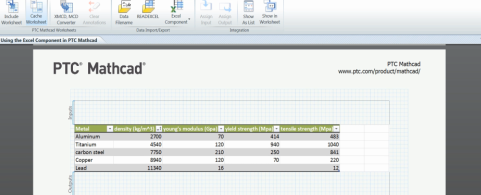 Do you have large data sets in Excel, which are essential to your design? But, you don’t want to have to use Excel for your engineering calculations? This is exactly what the Excel component in PTC Mathcad is designed for. The Excel component allows you to leverage data from existing spreadsheets, without having to convert the data or learn a new tool.
Do you have large data sets in Excel, which are essential to your design? But, you don’t want to have to use Excel for your engineering calculations? This is exactly what the Excel component in PTC Mathcad is designed for. The Excel component allows you to leverage data from existing spreadsheets, without having to convert the data or learn a new tool.
What are the benefits of using the Excel Component in Mathcad?
By being able to use the Excel component, it enables you to use both the familiarity of Excel tabular data capabilities with the calculation capabilities of Mathcad. It means that you will:
- Save time and effort
- Improve visibility and sharing
- Experience better integration with legacy systems
How does the Excel Component work?
The Excel component is straightforward to use. To start, take an existing Excel spreadsheet. Then select the content you would like to include in your Mathcad worksheet. All you need to do now is copy and paste this content directly into an Excel Component in Mathcad, with no data loss.
All data, calculations and formatting are maintained. Plus, you can further format the data in Mathcad to achieve a more presentable layout.
You can extract the data contained within the Excel component, so that you can use them in Mathcad. You can also include units in the definition, so you can leverage the software’s unit intelligence.
Using the Excel component is simple, yet powerful. The intuitive configuration provides many benefits, when it comes to working with data and exchanging that data between Excel and PTC Mathcad.
To find out more about Mathcad, why not take a look at the Mathcad Prime 3.0 datasheet:
